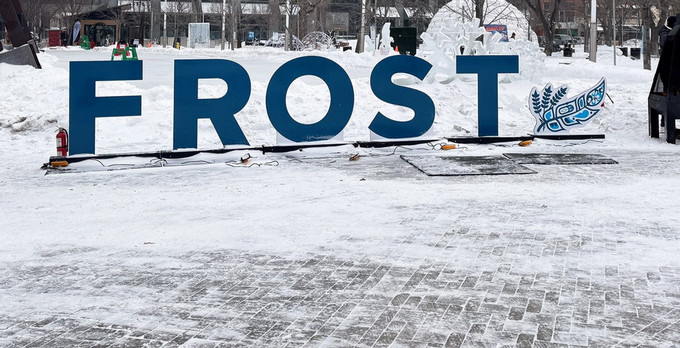The City of Regina’s 2025 FROST Festival leaps into the digital age, featuring innovative augmented reality (AR) installations created by University of Regina's Creative Technologies & Design (CTCH & DES) students. Thanks to CTCH & DES Assistant Professor Evie Johnny Ruddy and the Regina Downtown Business Improvement District, a new partnership offers U of R CTCH & DES students a hands-on, professional, and paid opportunity to share their artwork.
I’m proud of our students. It can feel vulnerable sharing your art publicly, especially as an emerging artist. I hope they get to witness people at the festival engaging with and enjoying their AR projects, and that the experience is rewarding for them. — Evie Johnny Ruddy, Assistant Professor, Creative Technologies & Design, Media, Art, and Performance
In a world where technology is rapidly evolving and digital media—including virtual reality (VR)—let users step into new worlds through a headset, augmented reality (AR) offers something different: a way to blend the physical and digital world together. Ruddy offers Pokémon GO and Instagram face filters as two examples where, when looking through smart devices, digital content is layered onto real spaces and people. Ruddy believes that AR has the power to transform the way we see and interact with our physical environments. “By adding digital art to our surroundings, we can create optical illusions, augment spaces with stories, sounds, and imagery to reimagine parks, neighbourhoods, and other urban environments, and create magical, immersive, embodied experiences that leave a lasting perceptual impact,” says Ruddy.
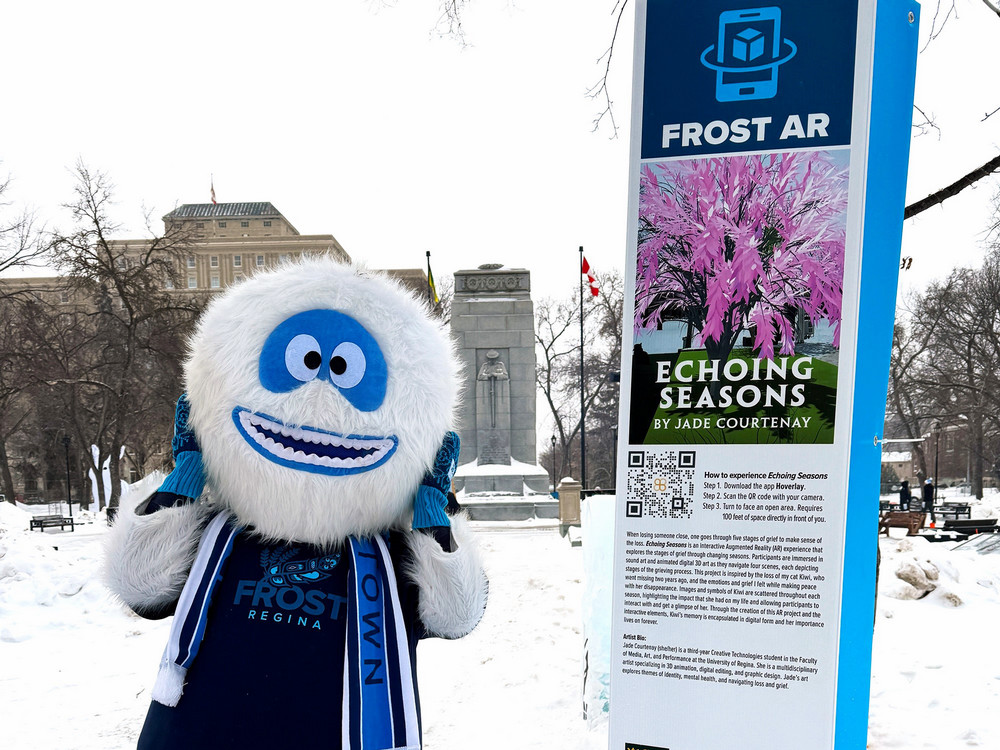
Jack the Yeti, the mascot of Regina's FROST Festival, stands in front of Echoing Seasons by Jade Courtenay, an interactive Augmented Reality artwork. Photo credit: University Communications and Marketing
Critical Theory, Art & Activism
Ruddy teaches a wide range of essential digital media and design skills for AR, from introductory 3D modelling and animation in Blender to user experience and sound design. "At the start of the course, many of the students have no experience with designing AR projects or creating content for augmented reality, however, by the end of the course, I'm always amazed by the students' ability to create visually stunning, engaging, playful, interactive, and immersive AR experiences," says Ruddy.
In addition to technical skills, the course prepares students for the multifaceted demands of creative industries, where artists must often serve as entrepreneurs—advocating, and marketing on their own behalf. By creating artwork for the FROST festival, students are provided a real-world platform to practise professional skills.
"Showcasing my work at the FROST festival has allowed me to promote myself and my work," says Maggie Robertson, a 4th-year CTCH student. For Robertson, the experience offered practical opportunities to develop essential industry skills, from writing artistic statements and bios to creating promotional materials like trailers and posters.
Beyond technical and professional development, FROST also provides students with a meaningful public platform to showcase their work—an opportunity that can feel intimidating. “I’m proud of our students,” says Ruddy. “It can feel vulnerable sharing your art publicly, especially as an emerging artist. I hope they get to witness people at the festival engaging with and enjoying their AR projects, and that the experience is rewarding for them.”
Select AR Artworks
Frosty Sports by Kadence Meredith
Kadence Meredith—who recently completed her undergraduate degree in Computer Science with a concentration in CTCH and is now pursuing a Master's in Computer Science—aims to transform how people experience winter sports with her AR project Frosty Sports, which allows users to perform figure skating tricks without ever stepping onto the ice.
Creating an AR experience uniquely tailored to Victoria Park's skating rink is no small feat. Meredith’s time at the U of R, however, has equipped her with the skills and mindset to tackle any challenge.
"An important perspective I've gained is that research is not linear," says Meredith. "It often takes educated experimentation to get projects and ideas where you want them—taking those failures as challenges to find better solutions.”
This philosophy helped her in developing Frosty Sports, which involved festival site visits to adjust digital assets and ensure they perfectly fit the festival space, along with multiple rounds of user testing. Given the festival’s proximity to the Saskatchewan Sports Hall of Fame, it was incorporated into her project with a section highlighting inducted athletes.
As a graduate student, Meredith is enjoying having the time and resources to continue pushing technological and artistic boundaries. She chose to continue her education at the U of R because of the unique opportunities available for her to not only continue to develop her skills and creative process, but also so she can stay connected to the Creative Technologies and Design community. “The people in the CTCH & DES program are so important to me, and that can’t be replicated at other universities,” says Meredith.
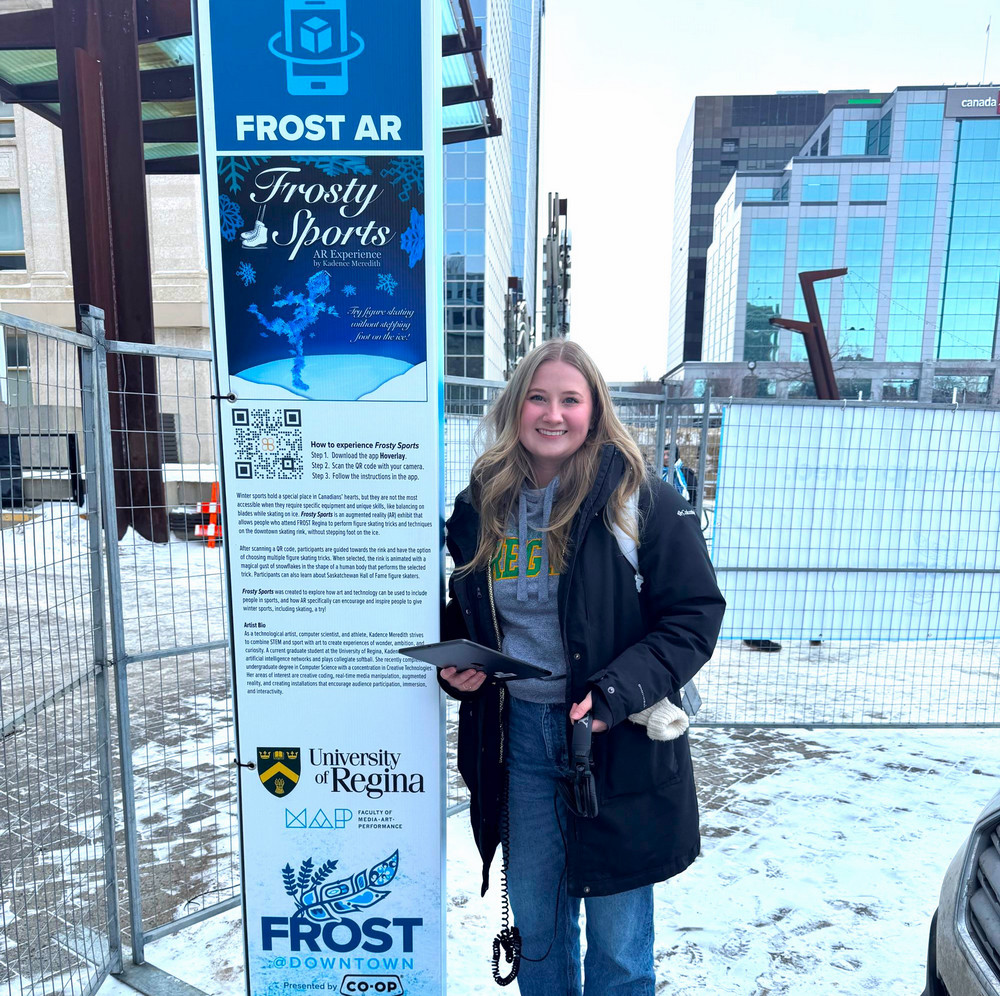
Escape the Cabin by Zachary Kenaschuk
Fourth-year CTCH student Zachary Kenaschuk transformed the concept of an escape room into an innovative AR experience for FROST festival attendees. As a 3D environment artist, he saw the project as an opportunity to reimagine how people can engage with escape rooms anywhere.
"Whenever you enter an escape room, there's an immediate vibe and feeling you get. It's almost as if you are instantly transported into the setting," says Kenaschuk. To create a similar sensation in his AR experience, sound played a crucial role. In a physical escape room, tactile sounds—like the creak of a drawer or the click of a lock—are key. In his AR version, Kenaschuk developed a rich soundscape, blending wind, creaking floorboards, ticking clocks, and ambient room noise. He even created distinct sounds to signal correct or incorrect actions, guiding users through the experience.
As an aspiring environment artist for gaming, animation or visual effects, Kenaschuk has always believed in the importance of conveying a story through the worlds he creates. “It helps give the environment meaning and believability. Without this aspect the environment can feel boring and like it has no reason for existing,” he explains. Presenting him with unique challenges, AR limited him to individual 3D models to communicate a story in an already existing physical environment—a stark contrast to the gradual storytelling possible in a two-hour animated film. This constraint pushed him to innovate and adapt his approach.
"Taking this course pushed me out of my comfort zone to learn new tools and methods for creating art," Kenaschuk reflects. "I was able to combine my existing skills with AR technology to create something I wouldn't have experienced otherwise."
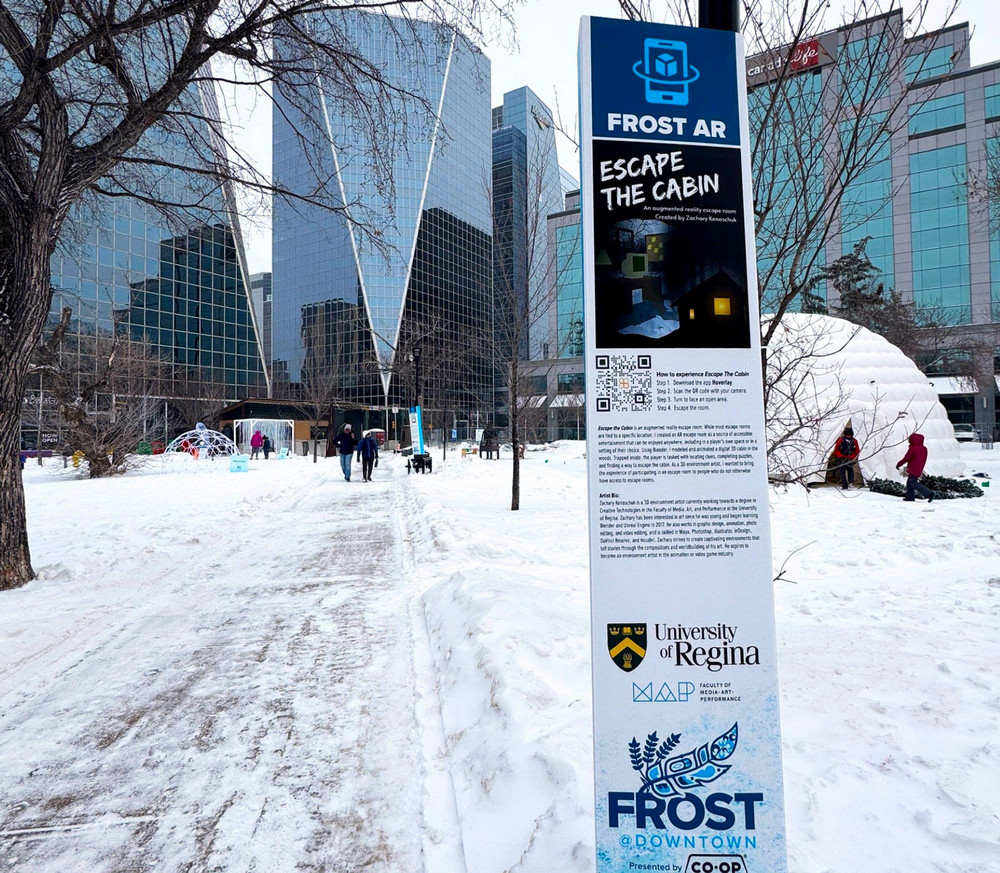
Poetry Pathway by Maggie Robertson
“Anxiety is an increasingly common affliction in our fast-paced society that prioritizes productivity and consumerism,” writes Robertson in the introduction to her artistic statement. Drawing from personal experience, her AR creation for FROST aims to combat anxiety—combining poetry, soundscapes, and whimsical visuals—to encourage users to slow down, be present, and enjoy their surroundings.
Initially for Robertson, diving into AR felt like a leap into the unknown. As an actor and digital artist, Robertson had no prior experience with AR but took the course out of excitement to learn and experiment with new and innovative technologies. She worried that her lack of 3D modelling and animation skills would hold her back, but she soon realized there were many ways to approach AR creation. As a multidisciplinary artist, Robertson was able to pull from a wide range of skills to create a fully immersive AR experience. Her background in acting helped her develop a voice and character for the narration, she used her experience with photography and Photoshop to transform images into cut-out elements for the AR space, and she applied her audio skills to record, edit, and mix lush soundscapes.
“I never thought that I would be able to make something like Poetry Pathway. Much of my success is thanks to Professor Evie Johnny’s instruction and patience,” says Robertson. By the end of the course, Robertson not only created her own AR artwork, but also mastered an unfamiliar program. “Now, I’m quite experienced in AR and have many new tools in my toolbox for future projects,” says Robertson.
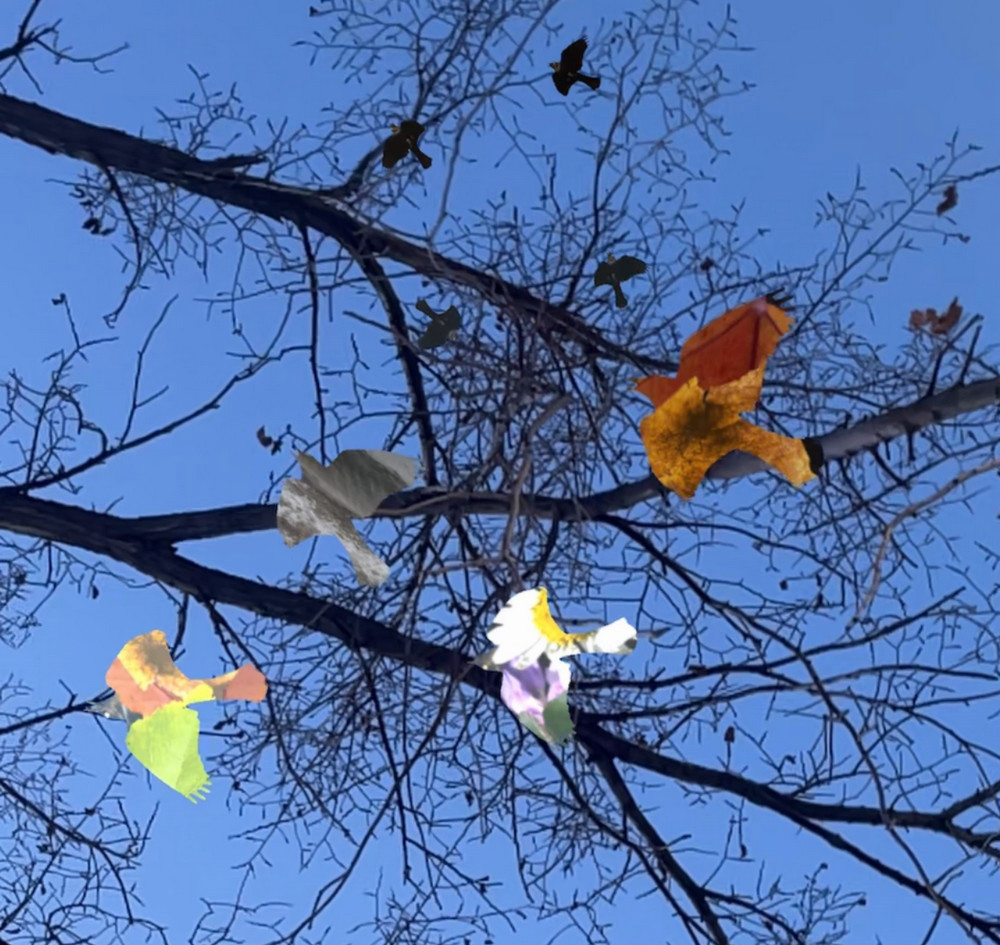
Ready to create your own AR experiences? Learn how Creative Technologies and Design can help you bring your creative vision to life!
About the University of Regina
2024 marked our 50th anniversary as an independent University (although our roots as Regina College date back more than a century!). As we celebrate our past, we work towards a future that is as limitless as the prairie horizon. We support the health and well-being of our 17,200 students and provide them with hands-on learning opportunities to develop career-ready graduates – more than 92,000 alumni enrich communities in Saskatchewan and around the globe. Our research enterprise has grown to 21 research centres and 9 Canada Research Chairs. Our campuses are on Treaties 4 and 6 - the territories of the nêhiyawak, Anihšināpēk, Dakota, Lakota, and Nakoda peoples, and the homeland of the Michif/Métis nation. We seek to grow our relationships with Indigenous communities to build a more inclusive future.
Let’s go far, together.
